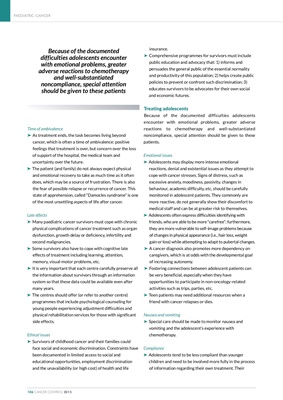
Time of ambivalence
‰ As treatment ends, the task becomes living beyond
cancer, which is often a time of ambivalence: positive
feelings that treatment is over, but concern over the loss
of support of the hospital, the medical team and
uncertainty over the future.
‰ The patient (and family) do not always expect physical
and emotional recovery to take as much time as it often
does, which may be a source of frustration. There is also
the fear of possible relapse or recurrence of cancer. This
state of apprehension, called "Damocles syndrome" is one
of the most unsettling aspects of life after cancer.
Late effects
‰ Many paediatric cancer survivors must cope with chronic
physical complications of cancer treatment such as organ
dysfunction, growth delay or deficiency, infertility and
second malignancies.
‰ Some survivors also have to cope with cognitive late
effects of treatment including learning, attention,
memory, visual-motor problems, etc.
‰ It is very important that each centre carefully preserve all
the information about survivors through an information
system so that these data could be available even after
many years.
‰ The centres should offer (or refer to another centre)
programmes that include psychological counseling for
young people experiencing adjustment difficulties and
physical rehabilitation services for those with significant
side effects.
Ethical issues
‰ Survivors of childhood cancer and their families could
face social and economic discrimination. Constraints have
been documented in limited access to social and
educational opportunities, employment discrimination
and the unavailability (or high cost) of health and life
PAEDIATRIC CANCER
106 CANCER CONTROL 2015
insurance.
‰ Comprehensive programmes for survivors must include
public education and advocacy that: 1) informs and
persuades the general public of the essential normality
and productivity of this population; 2) helps create public
policies to prevent or confront such discrimination; 3)
educates survivors to be advocates for their own social
and economic futures.
Treating adolescents
Because of the documented difficulties adolescents
encounter with emotional problems, greater adverse
reactions to chemotherapy and well-substantiated
noncompliance, special attention should be given to these
patients.
Emotional issues
‰ Adolescents may display more intense emotional
reactions, denial and existential issues as they attempt to
cope with cancer stresses. Signs of distress, such as
excessive anxiety, moodiness, passivity, changes in
behaviour, academic difficulty, etc, should be carefully
monitored in adolescent patients. They commonly are
more reactive, do not generally show their discomfort to
medical staff and can be at greater risk to themselves.
‰ Adolescents often express difficulties identifying with
friends, who are able to be more "carefree"; furthermore,
they are more vulnerable to self-image problems because
of changes in physical appearance (i.e., hair loss, weight
gain or loss) while attempting to adapt to pubertal changes.
‰ A cancer diagnosis also promotes more dependency on
caregivers, which is at odds with the developmental goal
of increasing autonomy.
‰ Fostering connections between adolescent patients can
be very beneficial, especially when they have
opportunities to participate in non-oncology-related
activities such as trips, parties, etc.
‰ Teen patients may need additional resources when a
friend with cancer relapses or dies.
Nausea and vomiting
‰ Special care should be made to monitor nausea and
vomiting and the adolescent's experience with
chemotherapy.
Compliance
‰ Adolescents tend to be less compliant than younger
children and need to be involved more fully in the process
of information regarding their own treatment. Their
Because of the documented
difficulties adolescents encounter
with emotional problems, greater
adverse reactions to chemotherapy
and well-substantiated
noncompliance, special attention
should be given to these patients